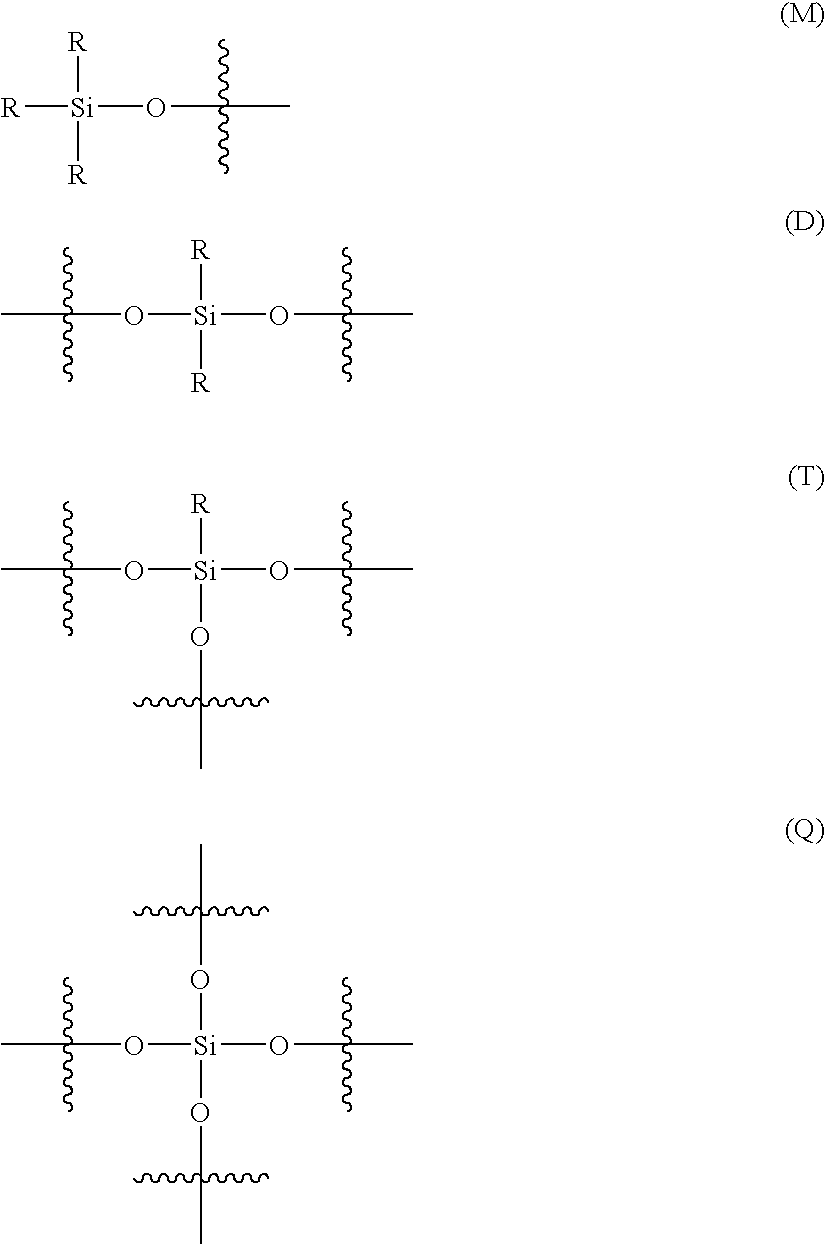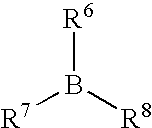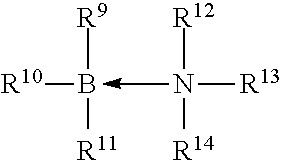Curable organosilicon composition
a technology of organosilicon and composition, which is applied in the direction of organic non-macromolecular adhesives, adhesives, etc., can solve the problems of reducing the functionality, selectivity, and usefulness of curable organosilicon compositions, and reducing the use of any of the aforementioned systems, so as to reduce production costs and energy expenditure, reduce temperature, and increase thermal stability
- Summary
- Abstract
- Description
- Claims
- Application Information
AI Technical Summary
Benefits of technology
Problems solved by technology
Method used
Image
Examples
example 1
[0072]To formulate the Composition 1, a first and a second mixture are formed in two vessels, respectively, using a Hauschild rotary mixer. The first mixture includes:
[0073]2.87 grams of hydroxyl-terminated polydimethyl siloxane (—OH PDMS) having a number average molecular weight of 44,000 g / mol, as the condensation curable organosilicon compound;
[0074]2.87 grams of methacryloxypropyl-terminated polydimethyl siloxane (MA-PDMS) having a number average molecular weight of 13,000 g / mol, as the radical curable organosilicon compound;
[0075]0.03 grams of dibutyl-tin-diacetate (DBTDA), as the condensation cure catalyst; and
[0076]0.23 grams of a complex of tri-n-butylborane complexed with 1.3 molar equivalents of 3 methoxypropylamine, as the organoborane-amine complex.
The second mixture includes:
[0077]5.51 grams of MA-PDMS having a number average molecular weight of 13,000 g / mol, as the radical curable organosilicon compound;
[0078]0.19 grams of isophorone diisocyanate (IPDI), as the amine-r...
example 2
[0081]Composition 2 is formed in the same way as Composition 1, except that different amounts of the —H PDMS, MA-PDMS, the organoborane-amine complex, the DBTDA, and the IPDI, are utilized. Also, methacryloxymethyltrimethoxysilane (MAMTS) is substituted for MAPTS. Specifically, 3.83 grams of —OH PDMS, 3.83 grams of MA-PDMS and 0.31 grams of the complex including tri-n-butylborane complexed with 1.3 molar equivalents of 3-methoxypropylamine is prepared, as a third mixture. Additionally, 7.47 grams of MA-PDMS, 0.25 grams of IPDI and 0.28 grams of MAMTS are combined, as a fourth mixture. After formation of the third and fourth mixtures, 2.07 grams of each of the third and fourth mixtures are combined in a polyethylene bag and mixed for 30 seconds to form the Composition 2. The Composition 2 is then evaluated in the identical way as the Composition 1 above, and the results are set forth in Table 1, below. Additionally, Composition 2 is re-cooled to 20° C. after measurements at 150° C. a...
control example 1
[0082]To formulate the Control Composition 1, a first and a second comparative mixture are formed in two vessels, respectively, using a Hauschild rotary mixer. The first comparative mixture includes:
[0083]4.42 grams of OH-PDMS, as the condensation curable organosilicon compound;
[0084]0.20 grams of DBTDA as the condensation cure catalyst;
[0085]0.39 grams of a complex of tri-n-butylborane complexed with 1.3 molar equivalents of 3-methoxypropylamine, as the organoborane-amine complex.
[0086]The second comparative mixture includes:
[0087]0.303 grams of Cab-O-Sil TS610, a dimethylsilylated fumed silica filler, commercially available from Cabot Corporation, of Boston, Mass.;
[0088]3.98 grams of methyl methacrylate;
[0089]0.21 grams of IPDI, as the amine-reactive compound; and
[0090]0.51 grams of 3-acryloxypropyltrimethoxysilane.
[0091]After formation of the first and second comparative mixtures, 2.12 grams of each of the first and second comparative mixtures are combined in a polyethylene bag a...
PUM
| Property | Measurement | Unit |
|---|---|---|
| temperatures | aaaaa | aaaaa |
| viscosity | aaaaa | aaaaa |
| boiling point | aaaaa | aaaaa |
Abstract
Description
Claims
Application Information
 Login to View More
Login to View More - R&D
- Intellectual Property
- Life Sciences
- Materials
- Tech Scout
- Unparalleled Data Quality
- Higher Quality Content
- 60% Fewer Hallucinations
Browse by: Latest US Patents, China's latest patents, Technical Efficacy Thesaurus, Application Domain, Technology Topic, Popular Technical Reports.
© 2025 PatSnap. All rights reserved.Legal|Privacy policy|Modern Slavery Act Transparency Statement|Sitemap|About US| Contact US: help@patsnap.com



